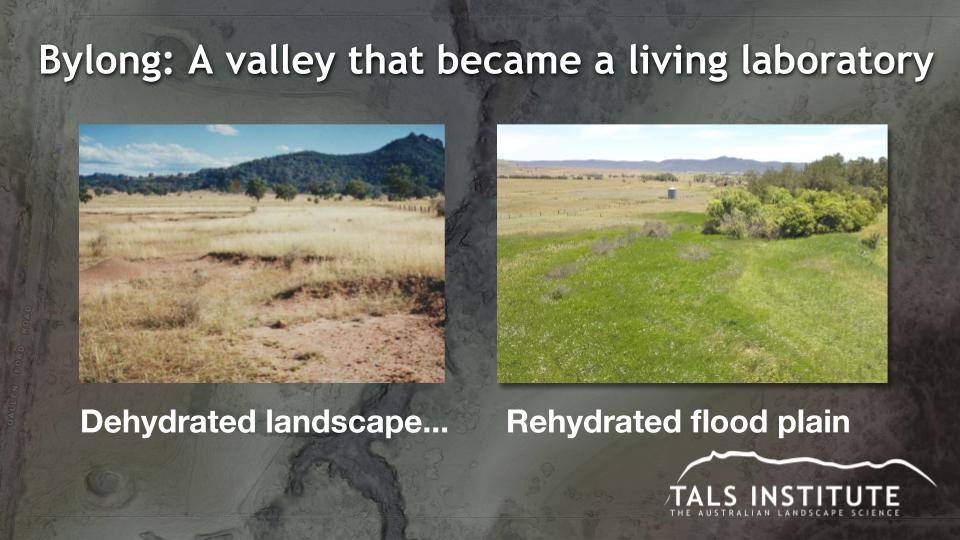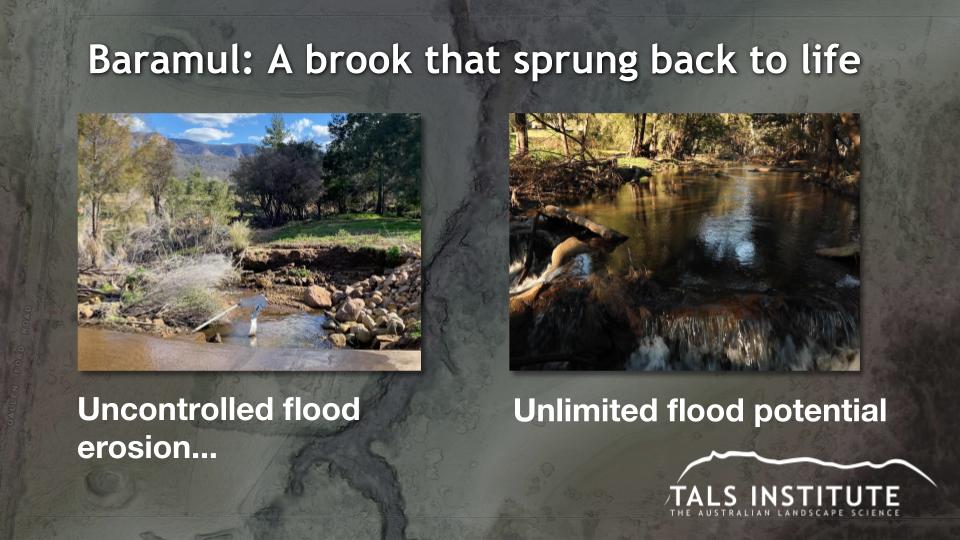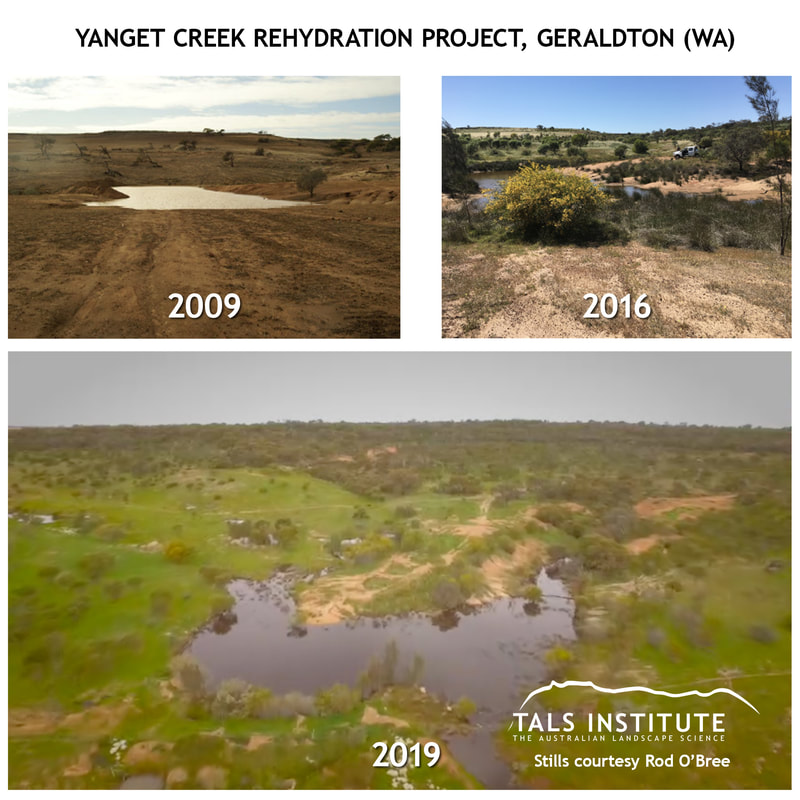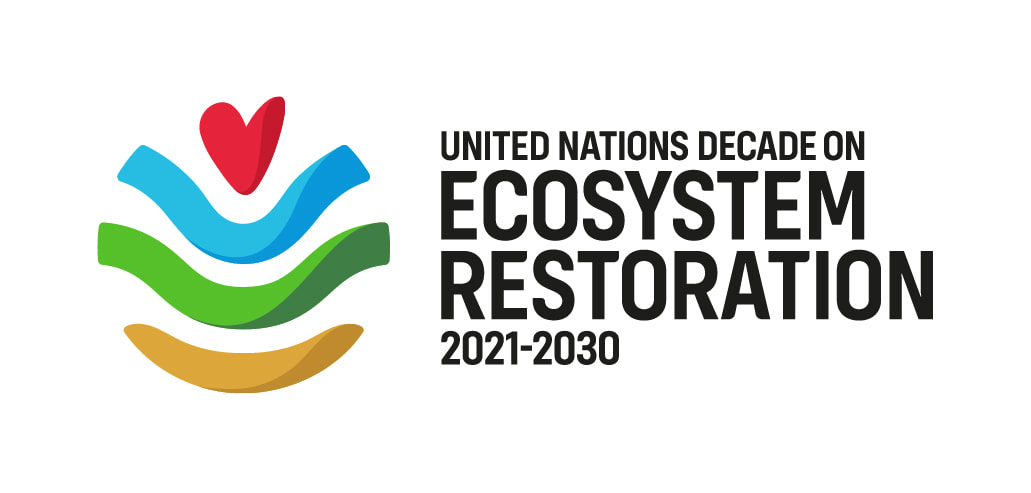NATURE BASED SOLUTIONS
FOR CLIMATE RECOVERY
"... global ecosystem services provide annual benefits in the range of USD 125–140 trillion in 2011."
~ Costanza et al (2014): 'Changes in the global value of ecosystem services'
"Nature Based Solutions can provide at least a third of the solution to climate change but receive less than 3% of funding from current climate finance."
~ Inger Anderson, Executive Director, UN Environment Programme, 22 September 2019
'NATURAL SEQUENCE FARMING' ('NSF')
BY PETER ANDREWS OAM
Natural Sequence Farming (NSF), formerly called 'Natural Farming Sequence' is a 'Whole of Landscape' restoration and management approach that is based on Peter Andrews' observations how the old Australian landscape, prior to human interference, functioned. The basis of NSF is the science that is in the Australian landscape ('The Australian Landscape Science' or 'TALS').
NSF seeks to reinstate the functions of the old Australian landscape when the landscape was so lush that it supported megafauna.
NSF serves as a landscape restoration method as well as a farming method. The latter has been described as 'Stepped Diffusion System of Broad Acre Hydroponics' by Prof Haikai Tane.
Peter Andrews OAM has transformed many properties across Australia.
'Tarwyn Park' was Peter Andrews' 'living laboratory' in the beautiful Bylong Valley - until it was taken over by the Korean coal mine Kepco. (Their mining proposal has been rejected. A judgment on a judicial review sought by Kepco on this decision is pending.)
'Baramul' Stud' is in Widden Valley, a sister valley of Bylong Valley, with very similar features, namely massive sandstone cliffs.
Find out more, below, as well as on the 'Case Studies' page of this website.
NSF seeks to reinstate the functions of the old Australian landscape when the landscape was so lush that it supported megafauna.
NSF serves as a landscape restoration method as well as a farming method. The latter has been described as 'Stepped Diffusion System of Broad Acre Hydroponics' by Prof Haikai Tane.
Peter Andrews OAM has transformed many properties across Australia.
'Tarwyn Park' was Peter Andrews' 'living laboratory' in the beautiful Bylong Valley - until it was taken over by the Korean coal mine Kepco. (Their mining proposal has been rejected. A judgment on a judicial review sought by Kepco on this decision is pending.)
'Baramul' Stud' is in Widden Valley, a sister valley of Bylong Valley, with very similar features, namely massive sandstone cliffs.
Find out more, below, as well as on the 'Case Studies' page of this website.
CASE STUDY - 'TARWYN PARK', BYLONG VALLEY
"The panel believes that NFS is a successful and sustainable farming system for the current enterprise at Tarwyn Park, where it has led to substantial agronomic and environmental improvements on the property.
"Central to the implementation of NFS at Tarwyn Park is the manipulation of the hydrologic regime, that has increased aquifer water storage providing effective sub-surface pasture irrigation.
"This has substantially increased pasture productivity, and avoids the evaporative water losses that occur with surface irrigation.
...
"The increases in pasture productivity appear to translate into increases in economic productivity, and hence the relatively small financial investments required by NFS implementation are likely to have substantially increased the profitability and market value of the property."
~ CSIRO Expert Panel Report - The 'Natural Farming Sequence', 2002
It is important to note that some of the observations made in the 2020 Report are outdated, specifically those re relatively low biodiversity on Tarwyn Park and benefits to Tarwyn Park from upstream properties not engaged in NSF. Since its publication in 2002, Tarwyn Park's ecosystem of mainly early succession plants has naturally evolved to include high biodiversity. In addition, we have evidence of other properties (such as Baramul in the Widden Valley) that clearly shows that automatic soil creation is achieved without badly managed neighbouring properties exporting their soils to a NSF managed property. At Baramul, sandstone cliffs and first succession plants, together with NSF implementations, are the cause of increased water holding capacity, nutrients and biomass in soil, not a neighbour's soil and water.
See the comments by Prof David Goldney, landscape ecologist, below, that support this.
See the comments by Prof David Goldney, landscape ecologist, below, that support this.
'BARAMUL' STUD, WIDDEN VALLEY, NSW
“Here [at Baramul Stud], in 18 months, you are seeing soil made on top of sand by a very simple process, and the organic layer is quite significant - that black layer that starts to form.
"I think it’s the most significant contribution to landscape restoration that I’ve seen in Australia. ...
“It all comes together in this very simple process that he has invented in a sense what was always there in the Australian landscape.
"I think Peter is a near genius. He’s a simple farmer who’s understood science better than most scientists, if not all scientists, and they come somewhat grudgingly to learn at his feet.”
Prof David Goldney, See extract of ABC Australian Story 'Of Droughts and Flooding Rains', originally broadcast on 13 June 2005.
CASE STUDY - JILLAMATONG, BRAIDWOOD, NSW
See also 'The Jillamatong Story', Soils for Life case study on the prime lamb, cattle, garlic, truffles and yabbies enterprise. Innovations included restoration of eroded areas and development of chain of ponds. Key results included vastly improved water quality through from chain of ponds, significant reduction in costs, 230% profit between 2005 and 2014.
OTHER CASE STUDIES
NATURAL SEQUENCE FARMING AS A BASIS
'Tallawang' - Greener Pastures through Restoring Landscape Hydrology, Soils for Life case study for sheep and cattle enterprise: Innovations included the construction of leaky weirs and swales to slow water flow. Key results included: 250% increase in carrying capacity, 15-23% profit margin on cattle production, constant river outflow regardless of inflow, improved landscape hydrology and increased native biodiversity.
AGROECOLOGICAL SYSTEMS OUTSIDE OF AUSTRALIA THAT ARE BASED ON 'WHOLE OF LANDSCAPE' PRINCIPLES (BUT NOT SPECIFIC TO THE AUSTRALIAN LANDSCAPE)
Bija Vidyapeeth – Earth University, Navdanya, Dehradun India: Focus on water and mulch farming; polyculture crops. The book 'Wealth Per Acre' by Dr Vandana Shiva includes case studies on productivity and nutrient increase per acre for polycultures compared to monocultures. The book 'Health Per Acre' by Dr Vandana Shiva shows how to increase nutritious crops while reducing costs.
Bec Hellouin farm, France - agroecological production; increase of soil carbon by 10% per year; see 'Heal the Earth through agriculture'; see also: https://www.fermedubec.com/la-recherche/les-rapports-scientifiques/
Bec Hellouin farm, France - agroecological production; increase of soil carbon by 10% per year; see 'Heal the Earth through agriculture'; see also: https://www.fermedubec.com/la-recherche/les-rapports-scientifiques/
ECONOMICS:
VALUATION OF ECOSYSTEM SERVICES
"... global ecosystem services provide annual benefits in the range of USD 125–140 trillion in 2011."
~ Costanza et al (2014): 'Changes in the global value of ecosystem services'
"By one estimate, restoring 350 million hectares of degraded and deforested lands around the world would create up to $9 trillion in net benefits.”
~ Verdone (2015). 'A Cost-Benefit Framework for Analyzing Forest Landscape Restoration Decisions'
"Here we argue that as the force of humanity increases on the planet, ecosystem service valuation will need to switch from choosing among resources to valuing the avoidance of catastrophic ecosystem change."
~ Limburger, O'Neill, Costanza, Farber (2002) 'Complex systems and valuation'
COST BENEFIT AND VALUE OF ECOSYSTEM SERVICES
Verdone (2015). A Cost-Benefit Framework for Analyzing Forest Landscape Restoration Decisions. Gland, Switzerland: IUCN, Gland, Switzerland:
"Ecosystem services (ES) are the benefits people obtain from ecosystems, according to the Millennium Ecosystem Assessment (MEA 2003): 'Ecosystem services can be classified as provisional (eg fibre, food, freshwater production), regulative (eg disease management, climate regulation, freshwater purification), supportive/ processes (eg nutrient cycling, pollination, soil formation) and cultural (eg cultural/religious/spiritual, aesthetic, educational, recreational).' " [emphasis added]
Biodiversity and Ecosystem Services - A business case for re/insurance, 2020, Swiss Re Institute
Costanza et al (2014): 'Changes in the global value of ecosystem services', Global Environmental Change 26 (2014) 152-158:
It is estimated that "global ecosystem services provide annual benefits in the range of USD 125–140 trillion in 2011".
'The Business Case - Why is safeguarding biodiversity and ecosystems important for business?' IUCN website
De Groot et al (2002), 'A typology for the classification, description and valuation of ecosystem functions, goods and services', Ecological Economics, Volume 41, Issue 3, June 2002, Pages 393-408:
"Economic valuation methods fall into four basic types, each with its own repertoire of associated measurement issues: (1) direct market valuation, (2) indirect market valuation, (3) contingent valuation, (4) group valuation.
"3.3.1. Direct market valuation
This is the exchange value that ecosystem services have in trade, mainly applicable to the ‘goods’ (i.e. production functions) but also some information functions (e.g. recreation) and regulation functions: New York City, for example, has sought to use natural water regulation services of largely undeveloped watersheds, through purchase or easements, to deliver safe water and avoided a $6 billion water filtration plant. This implies those watersheds are worth up to $6 billion to New York City. Wetlands trading programs allow property owners to capitalize on the demand for wetlands banks, with wetlands being sold in banks for $74,100–$493,800 per ha (Powicki, 1998).
3.3.2. Indirect market valuation
When there are no explicit markets for services, we must resort to more indirect means of assessing values. A variety of valuation techniques can be used to establish the (revealed) Willingness To Pay (WTP) or Willingness To Accept compensation (WTA) for the availability or loss of these services.
Limburger, O'Neill, Constanza, Farberd (2002) 'Complex systems and valuation', Ecological Economics, Volume 41, Issue 3, June 2002, Pages 409-420:
"Here we argue that as the force of humanity increases on the planet, ecosystem service valuation will need to switch from choosing among resources to valuing the avoidance of catastrophic ecosystem change."
"Ecosystem services (ES) are the benefits people obtain from ecosystems, according to the Millennium Ecosystem Assessment (MEA 2003): 'Ecosystem services can be classified as provisional (eg fibre, food, freshwater production), regulative (eg disease management, climate regulation, freshwater purification), supportive/ processes (eg nutrient cycling, pollination, soil formation) and cultural (eg cultural/religious/spiritual, aesthetic, educational, recreational).' " [emphasis added]
Biodiversity and Ecosystem Services - A business case for re/insurance, 2020, Swiss Re Institute
Costanza et al (2014): 'Changes in the global value of ecosystem services', Global Environmental Change 26 (2014) 152-158:
It is estimated that "global ecosystem services provide annual benefits in the range of USD 125–140 trillion in 2011".
'The Business Case - Why is safeguarding biodiversity and ecosystems important for business?' IUCN website
De Groot et al (2002), 'A typology for the classification, description and valuation of ecosystem functions, goods and services', Ecological Economics, Volume 41, Issue 3, June 2002, Pages 393-408:
"Economic valuation methods fall into four basic types, each with its own repertoire of associated measurement issues: (1) direct market valuation, (2) indirect market valuation, (3) contingent valuation, (4) group valuation.
"3.3.1. Direct market valuation
This is the exchange value that ecosystem services have in trade, mainly applicable to the ‘goods’ (i.e. production functions) but also some information functions (e.g. recreation) and regulation functions: New York City, for example, has sought to use natural water regulation services of largely undeveloped watersheds, through purchase or easements, to deliver safe water and avoided a $6 billion water filtration plant. This implies those watersheds are worth up to $6 billion to New York City. Wetlands trading programs allow property owners to capitalize on the demand for wetlands banks, with wetlands being sold in banks for $74,100–$493,800 per ha (Powicki, 1998).
3.3.2. Indirect market valuation
When there are no explicit markets for services, we must resort to more indirect means of assessing values. A variety of valuation techniques can be used to establish the (revealed) Willingness To Pay (WTP) or Willingness To Accept compensation (WTA) for the availability or loss of these services.
- Avoided Cost (AC): services allow society to avoid costs that would have been incurred in the absence of those services. Examples are flood control (which avoids property damages) and waste treatment (which avoids health costs) by wetlands.
- Replacement Cost (RC): services could be replaced with human-made systems; an example is natural waste treatment by marshes which can be (partly) replaced with costly artificial treatment systems.
Limburger, O'Neill, Constanza, Farberd (2002) 'Complex systems and valuation', Ecological Economics, Volume 41, Issue 3, June 2002, Pages 409-420:
"Here we argue that as the force of humanity increases on the planet, ecosystem service valuation will need to switch from choosing among resources to valuing the avoidance of catastrophic ecosystem change."
FOOD PRODUCTION AND LIVELIHOODS
- Reed et al (2017): 'Trees for life: The ecosystem service contribution of trees to food production and livelihoods in the tropics': "Using systematic review methodology we found 74 studies investigating the effect of forest or tree-based ecosystem service provision on a range of outcomes such as crop yield, biomass, soil fertility, and income. Our findings suggest that when incorporating forests and trees within an appropriate and contextualized natural resource management strategy, there is potential to maintain, and in some cases, enhance yields comparable to solely monoculture systems." Forest Policy and Economics, Volume 84, November 2017, Pages 62-71
SOIL EROSION AND BIOMASS
- Pimentel, D, Kounang, N (1998), 'Ecology of Soil Erosion in Ecosystems', Ecosystems 1, 416–426 (1998)
- Pimentel (2005), 'Soil Erosion: A Food and Environmental Threat', College of Agriculture and Life Sciences, Cornell University, New York
- Biomass: "Biomass refers to the above and below-ground plant material and is ususally expressed in grams dry weight per square meter (gDW·m−2)." From: Ecology of Insular Southeast Asia, 2006







